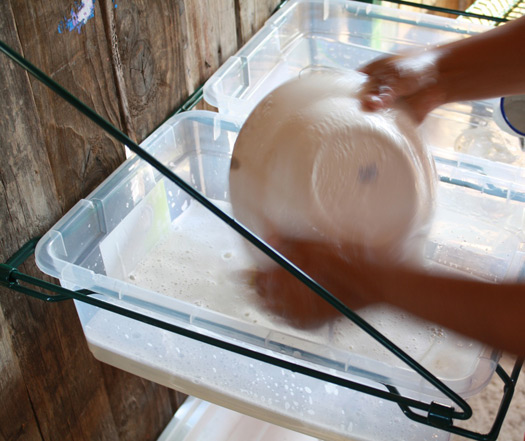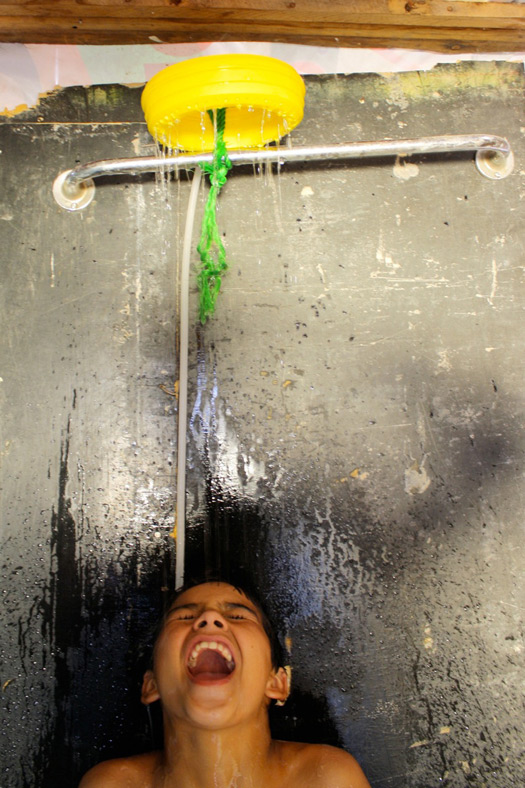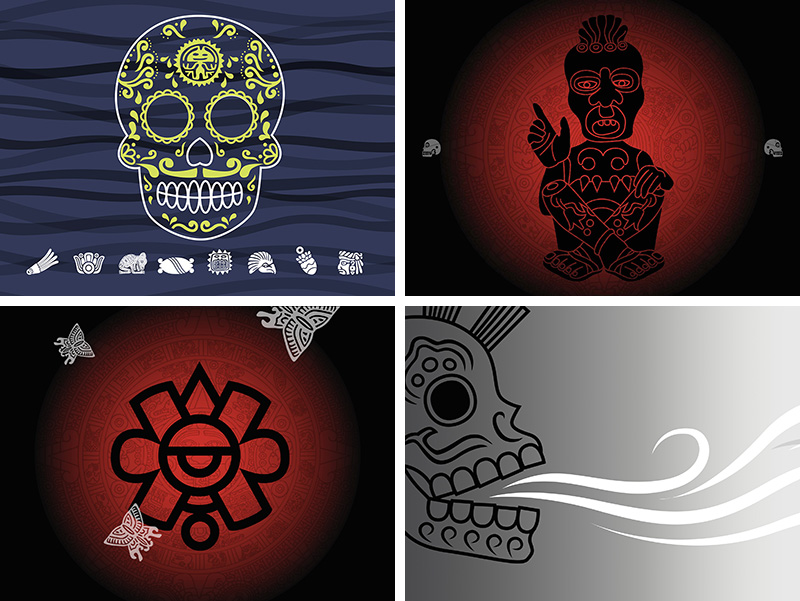
October 11, 2010
Safe Agua

A woman in the campamento tests the Relava kitchen workstation prototype designed by Jacqueline Black and K.C. Cho and manufactured by a Chilean company. Photos courtesy Designmatters/Art Center
The first collaboration between Designmatters at Art Center College of Design and Chile’s Un Techo para mi País creates fresh ideas for water usage in a Santiago slum.
For the teachers and students in the Environmental and Product Design departments at Art Center College of Design who signed up for the Safe Agua project in Chile, the first engagement with the problem was very close to home. An “empathy exercise” at Art Center’s Pasadena, California, campus, before a two-week field trip to Chile, forced the 15-member team to experience what it’s like to limit their daily water intake to one 5-gallon bucket, and laid the groundwork for understanding the challenges faced by the slum families.
That was readily apparent once the team arrived in Campamento San José, one of the main slums in Santiago. Residents there have access to clean water that is delivered three times a week by municipal truck — but they don’t have facilities or viable systems for running water, the lack of which complicates simple tasks such as bathing, cooking and laundry. For example, the 20 families living in Campamento spend an estimated 500 hours a week on laundry. Most residents bathe “by parts,” or pouring a can of water on separate areas of the body.

One of 10 MILA laundry centers constructed by Un Techo par mia País; design concept by Stephanie Stalker
Based on work with the Chile-based nonprofit Un Techo para mí Pais (A Roof for My Country), field research led to plans for six distinct but interrelated projects that address specific water-related needs. “This community has a unique problem,” explains Mariana Amatullo, vice president of Designmatters at Art Center, which initiated the project, referring to the availability of water but the lack of running-water systems. “The challenge was how to maximize the quality of life through solutions that allow water to be used more efficiently.”
In just over a year’s time, three of the projects have moved rapidly from research to implementation and testing:
Ducha Halo — a portable shower made from easily obtainable and inexpensive parts (from any Home Depot–like hardware store, for the equivalent of $17) that can be easily assembled. A DIY kit includes a simple pump, valves and hosing that yields a 15-minute long hand shower with water heated over coals.

Testing a Ducho Halo shower prototype designed by Jessica Yeh and Narbeh Dereghishian
ReLava — provides a kitchen workstation that is a sanitary and efficient way to wash dishes indoors, usually an arduous task. It repurposes simple plastic tubs into working sinks held by a wire frame that hangs from the wall (the runoff water can be reused).
Mila — a community laundry facility that replaces the tedious job of hand washing. Sponsored by consumer-goods company Unilever, the facilities are equipped with a gravity-fed water supply system and low-water-consumption washing machines, which provide not only a comfortable, hygienic place to launder clothes but also a community gathering spot (10 are already in operation). Moreover, residents can earn extra money by doing laundry for other families.

Diagram of the six interrelated Safe Agua projects. Artist: Ping Zhu
Three other projects are in earlier stages of development: for water purification (Agua Segura); a communications strategy to encourage innovation (Index de Innovación); and a running-water system (Gota a Gota, or “drop by drop”). What they have in common is a community-based model of design and social entrepreneurship. “We don’t believe in giving solutions to the people,” notes Julián Ugarte, an industrial designer who heads Un Techo’s Social Innovation Center and worked on Safe Agua, “but creating the solutions together.”
Editor’s note: A book about Safe Agua will be published by DAP in spring 2011. To see Elizabeth Bayne’s documentary film about the project, go here.
Observed
View all
Observed
By Ernest Beck
Recent Posts
“Dear mother, I made us a seat”: a Mother’s Day tribute to the women of Iran A quieter place: Sound designer Eddie Gandelman on composing a future that allows us to hear ourselves think It’s Not Easy Bein’ Green: ‘Wicked’ spells for struggle and solidarity Making Space: Jon M. Chu on Designing Your Own Path
 Ernest Beck is a New York-based freelance writer and editor.
Ernest Beck is a New York-based freelance writer and editor.


